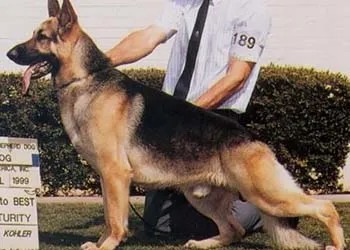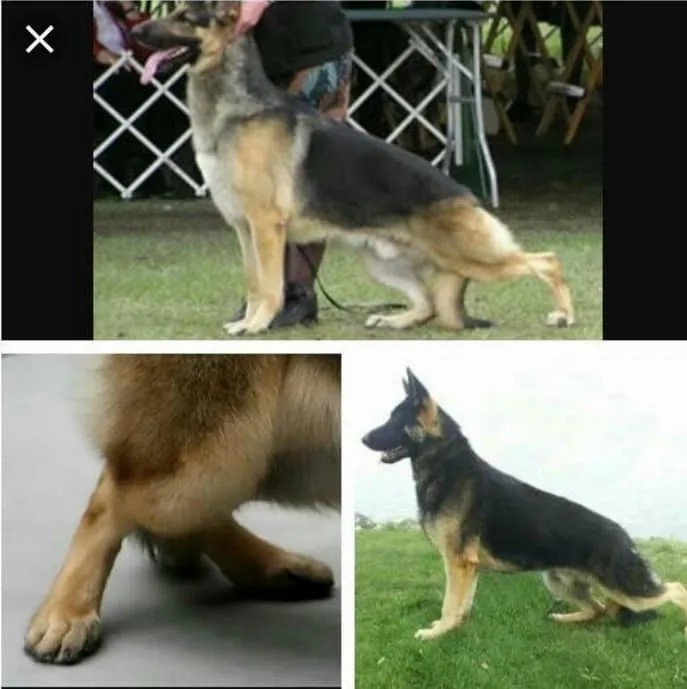Types of German Shepherd
Should you understand bloodlines in your next puppy purchase?
I hope to give some concise information about the German sheep-dog and the training of these dogs to be competent and reliable police dogs. A German shepherd is a working dog. It is a sheepdog that can be used for other tasks. For guarding yard and home, to protect the family, as a reliable surveillance dog to guard public safety and as a sleuth to search for missing persons, objects (explosives) and materials (drugs). Because of their high train ability and intelligence, they can also be trained to guide the blind and be very good service dogs. In order to perform in these various roles, dogs must have right nerves and right genetics. That comes from good breeding. So what gene pools are available in this breed?
East German Shepherd
Deutshe Demokratishe Republik deutscher Schäferhund
With the fall of the former Soviet Union, (1991) East Germany followed soon after, with the Berlin Wall coming down in 1990. There is no longer an East German Registry, so any dog born before 1990 is truly an East German dog. Because East and West Germany were separate for such a long time, the East German and West German Shepherd effectively became almost two separate breeds, since gene pools never mixed. East German shepherd dogs, also called D.D.R German shepherds (Deutshe Demokratishe Republik), tend to have dark pigmentation, a large, blocky head, big bone structure and a lean build. Their backs do not slope like the international show lines of German shepherds, but have a straight appearance. East German shepherds were bred more for their working abilities and have few problems with medical issues such as hip dysplasia. They have high energy levels and need sufficient activity (work) to keep them healthy. They are heavier boned and usually have large blocky heads. As you probably know, Slovakia and Czech Republic are now separate countries, (but were one country since World War I, in 1918) but we still refer to the gene pool as the old name, because genetically, these dogs are the same bloodline, and we still refer to them as the Czechoslovakian German Shepherd, not as Czech or Slovak.
The Czechoslovakian is descended from the East German Shepherd. Some people feel the Czechoslovakian dogs and East German dogs are separate sub-types. We feel that although there are some slight differences, the East German Shepherd to be essentially the same bloodline, as well, as both were bred in government run kennels, to be border patrol dogs or police dogs. The average East German, Hungarian and Rumanian also had dogs from these basic bloodlines, as they were not only in government kennels. Because the bloodlines crossed, between Czechoslovakian and East Germany, both behind the Iron Curtain, these were not isolated gene pools from each other, as is the case with West German versus East German Dogs. There are differences also in rate of maturity and physical development in D.D.R dogs versus West German dogs, but this can easily be researched by avid GSD enthusiasts. Many will find the word “Pohranicni Straze” and their breed warden, Jiri Novotny as the steward of this line of dogs. These lines normally have very good scenting ability. In today’s times, in the pedigree, it is very hard to find pure D.D.R bloodlines anymore, as these existed 25+ years ago. We feel the East German Shepherd is more defensive drive and less prey drive than the West German Shepherd working line. So ever since 1990, there is no longer officially an East German dog, but people still maintain this line separately in some cases. Many of the East German dogs have been mixed into the West German Working lines as well, but nevertheless, this line, or sub-gene pool, still exists and is very distinguishable in many cases, and there are breeders who specifically focus on these lines exclusively. The masculinity and femininity of the sexes is very distinguishable.
West German Show-line Shepherd
(The International line,sometimes called West German High Lines)
West German Shepherds have a clear division between show and working lines. Show lines have been bred primarily for their physical appearance and do not have the courage and strong work instincts of their working counterparts. Prior to the 1980’s, there was not as much division between the West German Showlines and Working lines. Canto vd Wienerau marked the beginning of the German show dog style taking its own direction and Lance of Fran-Jo who marked the beginning of the American show dog style taking its own direction, lived & were being used at stud at about the same time in GSD history, the end of the 60s & beginning of the 70s. Both Canto & Lance were saddle black and tan dogs, both were dogs who had more rear angulation than the dogs that went before them. Saddle pattern black and tans/reds descending from Arminius & Wienerau lines have dominated the German conformation scene ever since the beginning of the 80’s.
In the early 1980’s Hermann Martin became president of the S.V. Arminius was his kennel. His brother Walter owned Wienerau. The SV President always judges the working class males at the SIegershow, he is the one who decides which of the working class males are worthy of Sieger & VA ratings. Interesting that this is also the time when dogs of Wienerau & Arminius bloodlines became prominent & dominant in the German show scene! These dogs are representatives of the lines Quanto Wienerau, Canto Wienerau, Mutz Pelztierfarm, experts can still remember the name Marko Cellerland. The breedings started to be done without regard to temperament and working ability, but to create a very uniform looking, black-and-red dog with a saddle, as you see the dog to the right. They idea of making dogs very uniform, and almost cookie cutter leads us to the separation we have today in the lines. The idea of how a dog gaits in the show ring, no matter how tired he gets, also let some dogs develop a roach back, which helps a dog not be as tired after many hours of gaiting.
The main purpose of these dogs is to participate in exhibitions, in the breeding the biggest role is played not by the working qualities of the dog, but by its anatomical structure. They do require an I.P.O title before being bred so working ability is present but to a lesser degree somewhat than the working lines. The show lines have the most representation outside of Germany, and high popularity within Germany. The Black and Red dogs you see are probably what you’re thinking of and that’s the West German Showlines. The long coats, one of which is shown elsewhere on this site, also falls into this category. For many, the title west German shepherd refers to German show lines, while east German shepherd refers to working lines. The west German shepherds have a more sloped body than the east German shepherd, but not as much slope as American German shepherds. They retain a high energy level, so require lots of exercise. So the West German Shepherd working line, as opposed to showline, is what is we strive for, although occasionally we also produce a cross of West German Working line and showline if the dogs involved exhibits enough drive to do work..The masculinity and femininity of the sexes is very distinguishable.
Show line dogs are bred to be physically attractive, but lack the courage and strong nerves of a true protection dog
So in sum: there are two West German lines: working and show. The West German showline is not to be confused the the dog mentioned below, the American Showline.
West German Working Line Shepherd
Westdeutsche Arbeitslinie Deutscher Schäferhund
This dog is also from West Germany, but the West German Shepherd Working lines but is bred for success in the IPO world, and not in the show ring. The masculinity and femininity of the sexes is very distinguishable. The structure is built for work, and ability to do jumps and searching for the decoy in the blind and jumps with a dumbbell in its mouth. This dog is higher energy and higher prey drive than the West German Showlines. These dogs can be either pure black, sable, and black and tan. The black and red is not typically found in these lines. The high prey drive, sometimes called “high ball drive” can be leveraged for I.P.O as well as obedience training, giving the dog an incentive to work for his toy, or prey object. We feel the ratio f prey to defensive drive is higher prey than defensive drive compared to the D.D.R dog, or East German Working lines. The structure of this breed is what leads the dog to do his work, because a dog that doesn’t have the proper construction can’t work for long hours tending sheep, or doing some of the work the I.P.O trial requires. The dogs are bred with an eye toward working ability first, and looks second, but certainly these are handsome dogs. We feel this line truly represents what the breed was meant to be, a dog that is willing to work and retains working ability as a working breed.
American Showline (A.S.L)
Typical American Showline
Look at the dogs below? Do you see the feminization of these male dogs? Working ability is almost non-existent. Working ability has to be present in order for a dog to be considered a German Shepherd in our opinion and in the opinion of the breed founder. Dogs with “frog legs” were recent winners in Crufts this year, 2018. I don’t think this is what the founder of the breeder intended. We do not breed American Showline dogs.
Working line German Shepherds explained
The German Shepherd working line explained













